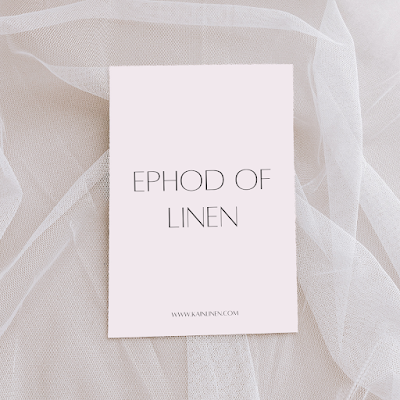The Significance of the Ephod of Linen in Religious Attire
In the tapestry of religious history and symbolism, the "ephod of linen" stands as a fascinating and spiritually significant garment.
Across various cultures and traditions, this simple yet profound piece of clothing has played a role in ceremonies and rituals.
In this article, we will explore the ephod of linen, its historical context, and its enduring relevance in diverse religious practices.
Understanding the Ephod of Linen
Before we delve deeper into its significance, let's clarify what an ephod of linen is.
An ephod is a vestment or garment worn by individuals with religious roles, often associated with priests or spiritual leaders.
It carries religious and symbolic importance and can be made from various materials, including linen.
The ephod of linen, as the name suggests, is made from linen fabric.
Linen, with its qualities of purity, comfort, and breathability, is a fitting choice for a garment intended for divine service.
This particular ephod is typically sleeveless and tunic-like in design, secured by a belt, and can be adorned with specific symbols or decorations depending on the religious tradition it belongs to.
The Significance of the Ephod
The ephod of linen has held immense significance in religious contexts throughout history:
- Symbol of Dedication: Wearing the ephod symbolized one's dedication to religious service and devotion to a higher power. It was a tangible representation of one's commitment to fulfilling sacred duties.
- Conduit for Divine Communication: In some traditions, the ephod was believed to facilitate communication with the divine. High priests would wear it when seeking guidance or making decisions on behalf of their community.
- Unity and Inclusivity: The ephod was often worn by individuals with specific religious roles, such as priests. However, it also emphasized the idea of unity and inclusivity within the religious community, where all members played a part in the spiritual journey.
- Recognition of Holiness: The choice of linen, a fabric known for its purity, reflected the holiness and sanctity of the rituals and ceremonies it was used in. It underscored the need for a clean and untainted connection with the divine.
The Ephod in Different Religious Traditions
The ephod, and specifically the linen ephod, appears in various religious traditions and contexts:
- Hebrew Bible: In the Hebrew Bible, the ephod is mentioned as a part of the priestly attire. It played a crucial role in rituals and was associated with seeking divine guidance through the Urim and Thummim, which were placed within the ephod.
- Ancient Egyptian Religion: In ancient Egypt, the ephod was worn by high priests and is depicted in hieroglyphs and artifacts. It was believed to be a conduit for connecting with deities.
- Christianity: In some Christian liturgical traditions, vestments with elements reminiscent of the ephod are worn by clergy during religious ceremonies. While not exactly the same as the biblical ephod, they carry the spirit of dedication and holiness.
Relevance Today
The ephod of linen, with its deep historical and symbolic significance, continues to resonate with people of faith today:
- Dedication and Commitment: It serves as a reminder of the dedication and commitment required in one's spiritual journey.
- Holiness and Purity: Linen, as a symbol of purity, encourages individuals to approach their faith with a clean heart and intentions.
- Seeking Divine Guidance: Just as it was used in the past to seek divine guidance, it prompts individuals to seek wisdom and spiritual insight.
- Inclusivity: The concept of inclusivity represented by the ephod encourages religious communities to welcome all members, recognizing their unique roles in the collective journey of faith.
Conclusion
The ephod of linen, a garment with profound historical and spiritual significance, serves as a bridge between the earthly and the divine.
Its symbolism of dedication, holiness, and unity continues to inspire individuals in their religious pursuits.
Whether worn by priests in ancient rituals or echoed in contemporary religious vestments, the ephod remains a potent symbol of faith and devotion that transcends time and tradition.

Posting Komentar untuk "Ephod of Linen Samuel"